Your cart is empty now.
Vasubandhu’s abhidharmakosa-Bhasya (ca. 380-390), besides its culminating achievement in streamlining the overall structure of the exposition of the preceding Abhidharma manuals, is unmatched by any of the preceding manuals in respect of its comprehensiveness-incorporating all important vaibhasika doctrines since the time of Abhidharma-mahavibhasa-of its excellent skill in definition and elucidation, and of its ability to clarify the difficult points involved in doctrinal disputations.
Added to these qualities is its great value as a brilliant critique and insightful re-evaluation of all the fundamental Sarvastivada doctrines developed up to its time.
Since its appearance, it has been used as a standard textbook for the understanding of not only the Abhidharma doctrines but all the fundamental Buddhist doctrines in general
Translated into Chinese by Paramartha in 563 A.D. and by Hsuan-tsang in 651-654 A.D., Hsuan-tsang’s Abhidharmakosa Bhasya was hailed as the “book of Intelligence”. In China, Japan and the Far-eat, too, the Kosa has generally been highly treasured as a textbook of fundamental importance for Buddhist studies.
Vasubandh’s Brilliant critique of the doctrines of the Vaibhasika was answered by the equally brilliants amghabhadra-a contemporary staunch defender and expounder of the doctrines of Vaibhasikas-in his masterwork, the Abhidharmanyayanusara, now extant only in Hsuan-tsang’s translation(653-654A.D.).
The Sanskrit text, considered for a long time to be irremediably lost, was discovered by Rahula samkrtyaana in 1935 in the Tibetan monastery of Ngor and was published by P. Pradhan in 1967 (1st edition)
Vasubandhu (ca.350-430 A.D.) was born in Purusapura in Gandhara and is, next to Asanga (ca330-405 A.D.), his halfbrother, the most famous personage of the Yogacara school.
He originally belonged to the Sravakayana school of the Saravastivadins and had already made a name for himself through the composition of numerous treatises when the was won over to the Mahayana by Asanga, sometime in his forties
Vasubandhu counts as the great systematizer of Buddhism and is one of the six great ornaments- six great commentators of the Buddha’s teaching.
Even though in the Kosa, Vasubandhu seems to be generally partisan to the “Hinayana” Sautrantikas, he too was evidently open-minded, of which fact the osa is a testimony, and accordingly, he did not seem to have become exclusively partisan to the tenets of any group as such –be it those of Hinayana-or Yoacara-sautrantika or Sarvastivada.
Gelong Lodro Sangpo (jurgen Balzer)-the translator-is a student of the late Ven. Trungpa Rinpoche. Born in 1953 in Germany, he received his first ordination in the Karma Kagyu Sangha in 1984, in France, and then moved to Gampo Abbey, Canada. From 1985-2002 he served as Secretary of the International Kagyu Sangha Association of Buddhist Monks and Nuns and Published its magazine The profound Path of Peace.
He completed the traditional three year retreat in 1996 and a four year study retreat in 2003. He also served for a few years as Acting Director of Gampo Abbey. He Was one of the Co-founders of Nitartha Institute and is a senior teacher at the Vidyadhara Institute, the monastic college of Gampo Abbey, since its inception.
His focus of study is in the systematic traditions of Buddhist abhidharma. In recent years, he has translated and published under the supervision of Prof.Ernst Steinkellner-Erich Frauwallner's The Philosophy of Buddhism (Motialal). At present, he is finalizing a translation of various books and articles by La Vallee Poussin and is also engaged in the project of translating the collected writings of Prof.Lambert Schmithausent from German into English.
1. By the kind generosity of Sylvain Levi, this sixth and last volume of the Kosa is enriched by the text of the kdrikiis of the first three chapters according to a Nepalese
manuscript of the thirteenth to fourteenth centuries. For the karikas of the other chapters, fragments of which appear in the Vytikhyti or which can be safely restored, see the notes to the translation. The Tibetan text of the karikiis: of the third chapter is mentioned in Cosmologie bouddhique.
2. Four indexes have been created:
i. a general index; ii. gathas: or karikas cited in the text or in the notes;
iii. the first words of the citations of sutras or sastras;
iv. names, scholars, sects, books, Siitras, Abhidharma.
The words Meru, Jambudvipa, Trayastrimsas, etc., are placed in the general index.?
3. The Additions and Corrections' contain the notes that I marked haphazardly in my working copy. I have not undertaken either the accumulation of complete documentation, clearly impossible, or a conscientious revision of the translation.
4. The Introduction does not contain everything that I wanted to put in it.
a. It lacks a summary of the doctrines of the Kosa. The recent study by Rene Grousset, Analyse de l' Abhidharmakosasastra.: can favourably substitute for what I might have written. Besides, I had started to examine various problems of general interest which Kosa clarifies: NirviiJ1Ja (1925), Morale bouddhique (1927), Dogme et philosophie du Bouddhisme (1930). I plan a Chemin de Nirvana (Kosa, chap. v-viii) and an Histoire de l'Abhidharma (Sutras; Kosa; Siddhi) which will explain what the Sarvastivada added to the early Abhidhamma."
The materials gathered together for the study of some points, either important or difficult, make up a very considerable amount. They are in the course of publication under the title Documents d'Abhidharma. The first part, on the Asamskrtas (according to the Vibhasa and Samghabhadra), is published in the Bulletin de l’Ecole Francoise d'Extreme-Orient. It will be followed by notes on the authenticity of the Scriptures and the sacred nature of the Abhidharma; the doctrine of the refugees and the purity of the body of the perfected being (arhat); the controversy on time, the moment and the atom; the two, the four and the three truths; the possessions (prapti) and the traces (vasana); the Darstantikas-Sautrantikas: the Yogasutras and the Abhidharma.
b. One will find here [in my Introduction], along with the bibliography of the Kosa, only the beginnings of a study on Vasubandhu's sources":
A. Annotated edition of the comments that appear in the foreword to Cosmologie bouddhique (1913): the place of the Abhidharma in the old literature of Buddhism, the place of the Kosa in the Abhidharma literature; pp. vi-xvi
B. Bibliography of the Kosa and its commentaries, European sources, Sanskrit sources, etc.; pp. xvii-xxiii
C. The question of the date of Vasubandhu; pp. xxv-xxviii
D. The seven canonical treatises of the Abhidharma; pp. xxix-xlii
E. Some masters of the Vibhasa; pp. xliii-li
F. Some schools of the Vibhasa; pp. lii-lix
G. The Abhidharma of Sariputra; pp. lx-lxii
H. The three editions of the Abhidharmasara; pp. lxiii-lxv
The study of the Vibhasa, facilitated particularly by the references of Saeki Kiokuga (ed. of the Kosai, and the study of the old Abhidharma treatises show clearly all that Vasubandhu owes to the Sarvastivadin sources: Vasubandhu speaks the truth when he says that this book is an explanation of the doctrines of the Vaibhasikas of Kasmir: the Kosa is, by definition, a judicious and well-ordered analysis of the Vibhasa. But the Kosa, as we know, is also the refutation of several essential doctrines of the Vibhasa. Vasubandhu, who the orthodox Vaibhasika Samghabhadra calls "the Sautrantika", sets the view of the Sautrantikas or his own views against the views of the Sarvastivadin-Vaibhasikas: here we have very little information on the sources that he uses; he makes use of data foreign to and undoubtedly later than the vibhasa, the Darstantikas-Bhadanta-Dharmatrata cited by the Vibhasa. We will see more clearly when we have read Samghabhadra who gathers information on Srilata, who must be one of the Sautrantika sources of Vasubandhu.?
My task is to offer to my colleagues the information-such as it is and. in all its simplicity that I have available. The Kosa and the Abhidharma remind one of the definitions the poet gave of the boar, animal proper convivianatum ("an animal created for conviviality"). Concerted and numerous efforts are required to sort out, if not the theories-too free of metaphysics, more complicated than profound-then at least the history of the theories and books.
The Three baskets (Pitaka) & The Abhidharmakosa-Bhasya
AA The two baskets of the Vinaya and Dharma & the first Matrkas The oldest literature of Buddhism is divided into two parts or baskets:
Vinaya: the rule and procedures of monastic discipline, history of and commentary on the discipline;
2. Dharma:" Since then called Sutra, the collection of discourses that explain the Dharma, that is to say, all that directly or indirectly concerns the path of salvation: to some extent the moral law, incapable though it may be of definitively releasing from unsatisfactoriness; but above all the Eightfold Noble Path, the methods of contemplation and of meditation that lead to the definitive. release from unsatisfactoriness, i.e., to nirvana: this is the essential thing, for the sole flavour of the True Doctrine is the flavour of release.
The Sutra or Dharma cannot be practiced exclusively. Greed (lobha) and hatred (dvesa) are combated effectively only by destroying delusion (moha); the most humble moral law implies right view (samyagdrsti), right view concerning life after death and ripening of action. All the more so, the elimination of defilements and their most subtle traces, indispensable for the liberation from the cycle of transmigrations, implies penetrating insight into the nature of phenomena, into their accidental and transient characteristics. The satras always contained, one may believe, much psychology or ontology." When catechesis, {i.e., oral instruction by the method of question and answer,} developed,
| Preface to the 1971 edition of Abhidharmakosa de Vasubandhu"by Etienne Lamotte | ||
| Bibliographical Addendum by Hubert Durt | ||
| Preface | ||
| Introduction | ||
| Remarks of the Translator | ||
| Abbreviations | ||
| Outline of Chapter One | ||
| Chapter One: | Exposition of the Elements (Dhatunirdesa) | |
| Endnotes to Chapter One | ||
| Outline of Chapter Two | ||
| Chapter Two: | Exposition of the Faculties (Indriyanirdesai | |
| Endnotes to Chapter Two | ||
| Outline of Chapter Three | ||
| Chapter Three: | Exposition of the World (Lokanirdesa) | |
| Endnotes to Chapter Three | ||
| Outline of Chapter Four | ||
| Chapter Four: | Exposition of Action (Karmanirdesa) | |
| Endnotes to Chapter Four | ||
| Outline of Chapter Five | ||
| Chapter Five: | Exposition of the Proclivities (Anusayanirdesaa) | |
| Endnotes to Chapter Five | ||
| A Summary of the Path | ||
| by Louis de La Vallee Poussin | ||
| Outline of Chapter Six | ||
| Chapter Six: | Exposition of the Path and the Persons [in whom the Noble Path Arises] (Margapudgalanirdesa)] | |
| Endnotes to Chapter Six | ||
| Outline of Chapter Seven | ||
| Chapter Seven: | Exposition of the Cognitions (Jnananirdeia) | |
| Endnotes to Chapter Seven | ||
| Outline of Chapter Eight | ||
| Chapter Eight: | Exposition of the Meditative Attainments (samapattinirdesa) | |
| Endnotes to Chapter Eight | ||
| Outline of Chapter Nine | ||
| Chapter Nine: | Treatise of the Refutation of the Person | |
| (Pudgalapratisedhaprakarana) | ||
| Endnotes to Chapter Nine | ||
| Bibliography | ||
| A. Selected primary sources (Sanskrit, Pali, Chinese, Tibetan') | ||
| Indices | ||
| Selected secondary sources | ||
| Indices | ||
| Sanskrit-English Index-Glossary | ||
| English-Sanskrit Index-Glossary | ||
| Gaths and Karikas | ||
| Fragments of Sutras and Sastras | ||
| Name Index: Sutras, Books, Scholars, Schools, etc. |

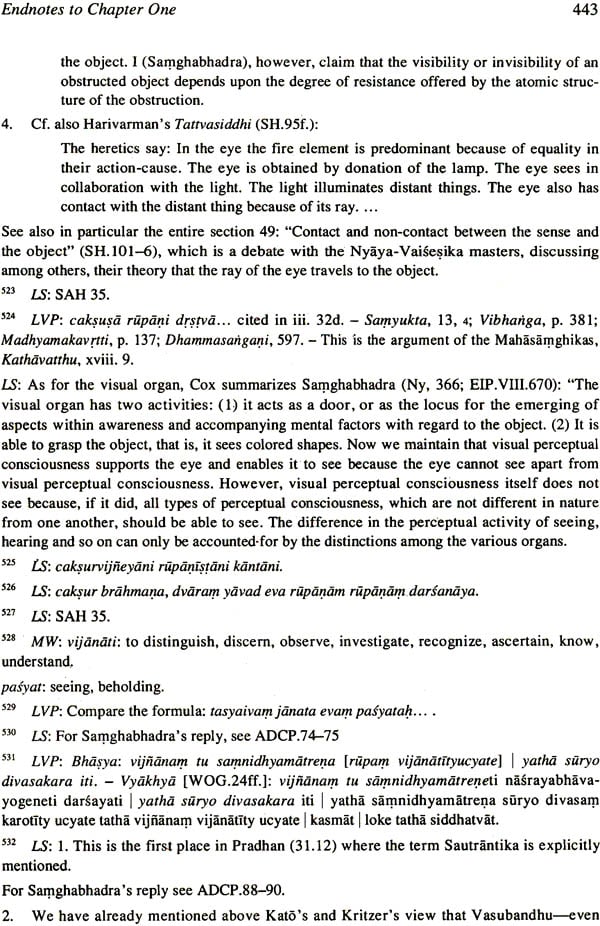
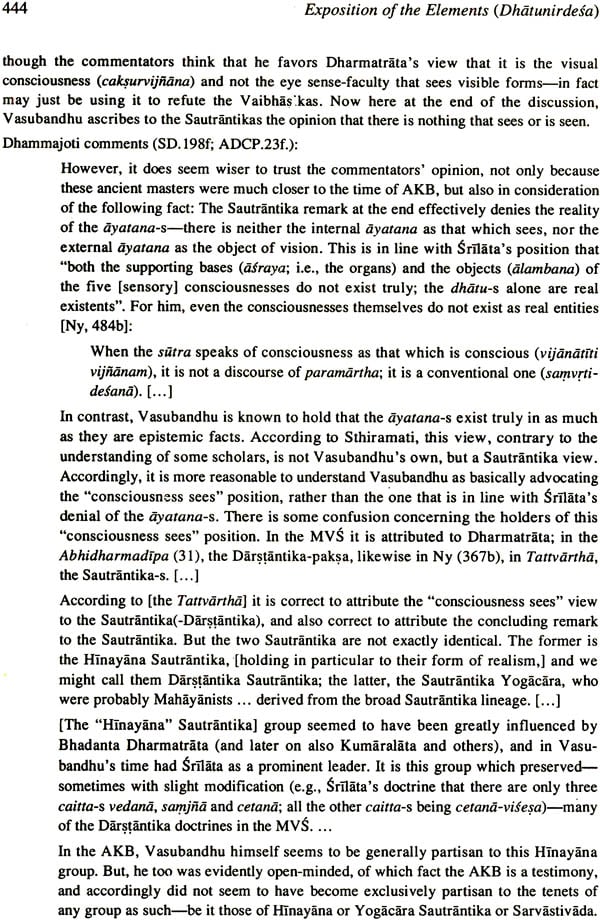
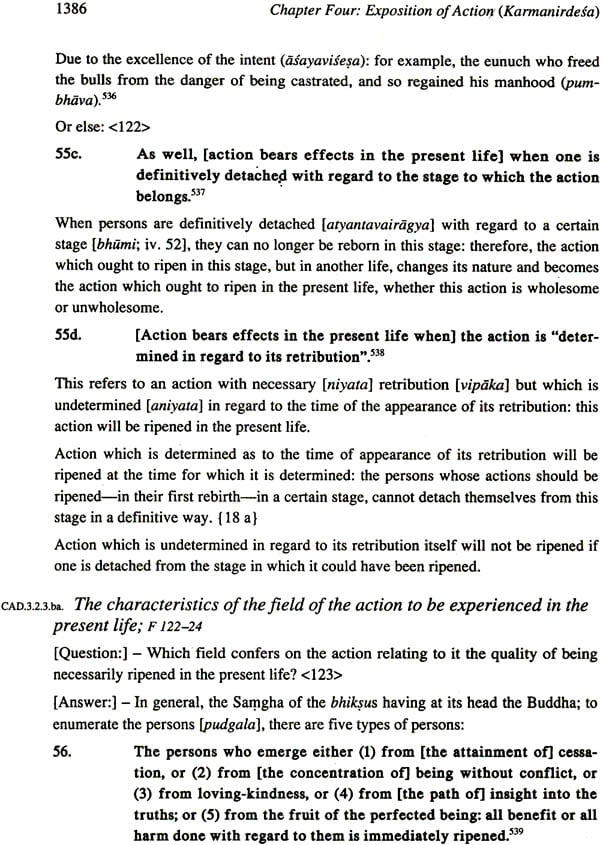


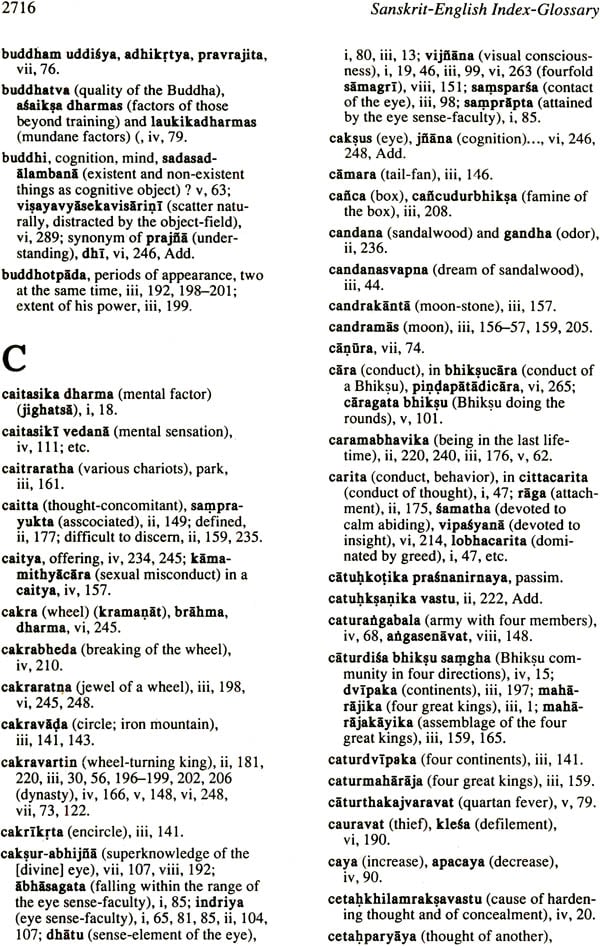
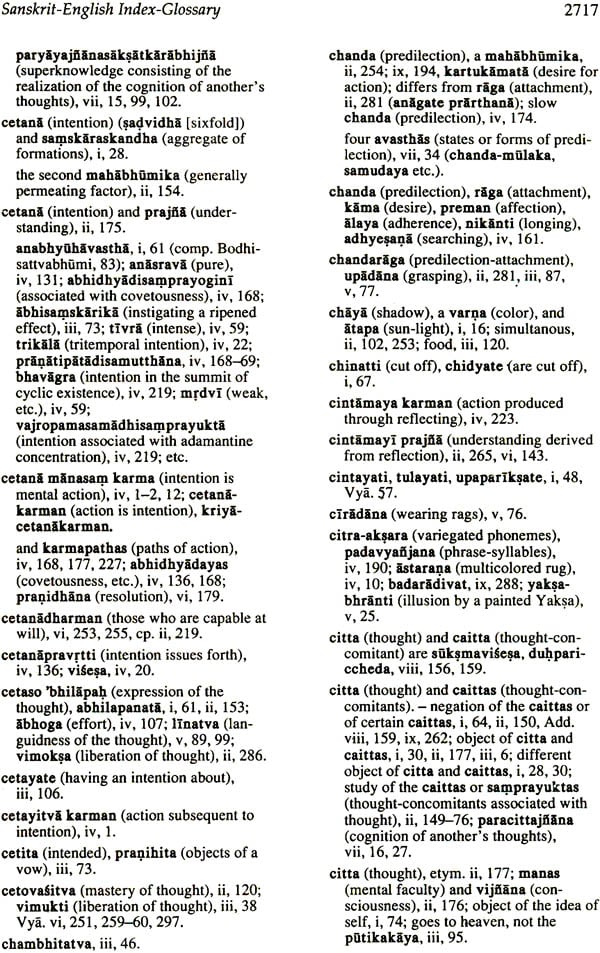
Delivery and Shipping Policy
- INTERNATIONAL SHIPPING
- Rs.1000-1100/kg
- ESTD. Delivery Time: 2-3 weeks (depending on location)
- Bubble Wrapped with Extra Padding
- NATIONAL SHIPPING
- NCR: Rs. 30/half kg
- Standard: Rs. 80/half kg
- Express shipments also available on Request
- ESTD. Delivery Time: Ranging from 1-4 days up to 7 business days (Depending on your choice of Delivery)
- TRACKING
- All orders; national or international, will be provided with a Tracking ID to check the status of their respective orders
- Depending on the Shipping Service, Tracking ID may be used on their respective tracking portals
Frequently Asked Questions (FAQs)
Domestic Shipping: 3-4 Days (after shipping)
International Shipping: 1-2 weeks (based on your location)
You will receive an email once your order has been shipped or you can email us if you didn't receive tracking details (info@mlbd.co.in)
Every book that we sell is the latest edition except all the rare books
Yes, we do provide free shipping, only on domestic orders (within India) above Rs.1500










![The Rishukyo [Buddhica Britannica Vol.3]: The Sino-Japanese Tantric Prajnaparamita in 150 Verses (Amoghavajra's Version)](http://www.motilalbanarsidass.com/cdn/shop/products/RISHUKYO_large.jpg?v=1675417651)
